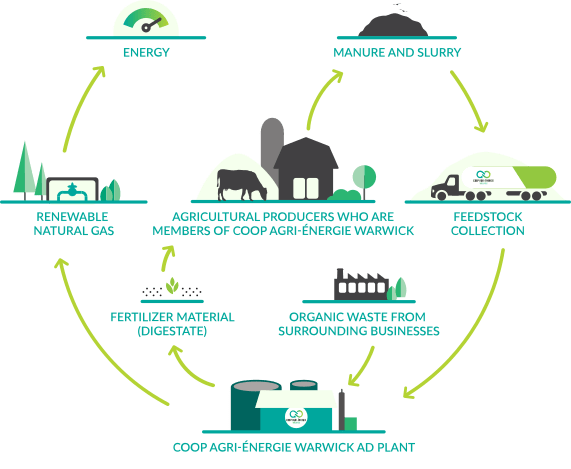Towards energy autonomy through… cow poo?

Renewable gases will be essential by 2050 to support the independence of territories from external energy supplies. Agricultural biomethanization, which transforms manure and slurry to produce methane gas, is a fairly widespread process in the world, particularly in Europe and the United States. It avoids emissions into the atmosphere while recovering the energy produced by the decomposition of organic matter.
Less widespread, however, is the implementation of this process under a logic of inter-cooperative projects, favoring a promising model on the environmental, economic and social levels. This is the case of the Coop Agri-Énergie Warwick, the very first agricultural cooperative dedicated to the production of renewable energy in Quebec (Canada). On the territory of the Arthabaska county – headquartered in Victoriaville, about halfway between Montreal and Quebec City – this regional cooperative brings together twelve agricultural producers creating renewable natural gas (RNG) from dairy cattle slurry and manure mixed with residual organic materials from surrounding businesses. The project is the result, however, of the collaboration of a greater number of partners on several levels: operational, technical, financial, and energy. Coop Carbone, a non-profit solidarity cooperative, is responsible for the development and operationalization of the biomethanation complex, with a goal to replicate the model elsewhere in Quebec. Among the players involved is the main natural gas distribution company in Quebec, Énergir, which has undertaken to buy and inject into its network all of the cooperative’s RNG production for a period of 20 years. The project’s investments of $12 million come from the public sector (provincial and federal) and the social finance.
In operation since June 2021, less than two years after the creation of the cooperative, the Warwick biomethanation site acts as a lever for economic development and for energy transition, respecting the reality of each of the member producers and the regional agricultural context. Under a principle of circular economy, the residual materials of the members are transformed in the site into methane, which will be purified into renewable natural gas. To complete the loop, the digestate by-product (fertilizer) will be returned to the farms. In this process, from 50,000 tonnes of residual organic matter, 2.3 million m3 of RNG are injected annually into the gas network, thus avoiding emissions of 6,500 tonnes of CO2 per year. This would correspond to the withdrawal of 1,600 cars from the roads, or of 70% of the car fleet of the municipality of Warwick (5,000 inhabitants).
Although cities generate a significant amount of waste, biomethanation is generally not used in urban contexts given the challenge of supplying and effectively treating organic waste, which is often mixed with other materials such as plastics and metals. Added to this are potential odor and noise issues in densely populated areas. However, there are experiments with smaller-scale urban biogas projects to treat local organic waste streams and produce renewable energy for local use. Projects along these lines, such as using food waste from restaurants and supermarkets to produce biogas for cooking and heating households and commercial buildings, remain avenues to explore as part of the equation for sustainable energy supply to cities.
Images: Coop Agri-Énergie Warwick/agrienergie.coop
Sources
Bautista Angeli, J.R., Morales, A., LeFloc’h, T. et al. Anaerobic digestion and integration at urban scale: feedback and comparative case study. Energ Sustain Soc 8, 29 (2018). https://doi.org/10.1186/s13705-018-0170-3
Bolzonella, D., Mıcoluccı, F., Battısta, F. et al. Producing Biohythane from Urban Organic Wastes. Waste Biomass Valor 11, 2367–2374 (2020). https://doi.org/10.1007/s12649-018-00569-7
Coop Agri-Énergie Warwick https://www.agrienergie.coop/
Coop Carbone https://coopcarbone.coop/projet-phares/coop-agri-energie-warwick/
United Nations Environment Programme (UNEP). (2019). Global Trends in Renewable Energy Investment 2019. https://www.unep.org/resources/report/global-trends-renewable-energy-investment-2019
